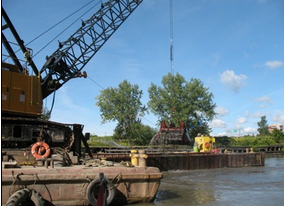Sep 25
2014
EPA’s new Great Lakes plan helps Buffalo River

By 2019, enough toxic pollutants should be removed from the Buffalo River to thrust its rebound toward a level of health that would allow people to once again safely eat the fish and possibly even enjoy a swim.
That’s one of the chief goals of the Environmental Protection Agency’s second phase of its Great Lakes restoration initiative.
But Jill Jedlicka, the executive director of the Buffalo Niagara Riverkeeper, cautioned that there won’t be instant gratification for fishermen and swimmers.
“It doesn’t mean that by 2019 that you will be able to eat the fish or swim in the water,” said Jedlicka, whose nonprofit group is part of a public-private partnership tasked with restoring the Buffalo River. “It will still take many, many years for it to recover and rebound.”
For instance, the Buffalo Sewer Authority’s remedial plan to significantly reduce sewer overflows throughout city waterways, including the Buffalo River, has projects that are spread out over two decades.
The Buffalo River is in a rare group of waterways, but for bad reasons.
It is among 43 waterways—26 in the United States, 12 in Canada and five shared by both countries— that the two nations identified as being in critical need of restoration from decades of environmental degradation. The results of the toxic pollution are that people can’t eat the fish, they can’t swim in the water and other recreation is at your own risk.
The EPA calls these waterways “Areas of Concern,” and there are 29 left on the list that are entirely in the United States or shared by both countries.
In addition to the Buffalo River, the Niagara River and Eighteenmile Creek are the only other local waterways on the list.
Although the designation sets the stage for intervention, the process has moved slowly.
Specifically, the EPA has delisted only two waterways—Pennsylvania’s Presque Isle Bay in 2013 and Upstate New York’s Oswego River in 2006—since the adoption of the binational 1987 Great Lakes Water Quality Agreement that led to designating these troubled waterways.
In comparison, Canada has delisted three waterways.
The EPA’s new plan includes the Buffalo River as one of 10 waterways that will have all the remedial work completed by 2019—a milestone that means it could be removed from the list. The only other New York State waterway on the top-10 list is the Rochester Embayment.
The Buffalo River is a good example of how the cleanup efforts are a huge undertaking.
Indeed, the river’s restoration effort started in 1989 and will hit the three-decade mark once the EPA’s new five-year plan reaches its deadline. Six years went to assessing the health of fish and wildlife and determining what the cleanup steps would be for the river.
The dredging of the river is almost complete and the next focus will be to restore more lost habitats such as wetlands that filter the bad stuff from reaching the river. The clean-up bill will reach $75 million, Jedlicka said.
“Riverkeeper has worked for 25 years to secure highly competitive funds and attention for our local waterways, and with the 2014 GLRI Action Plan, the Buffalo River is now recognized as one of the nation’s top restoration priorities,” she said.
For more details on the EPA’s plan, read Wednesday’s New York Times article.

